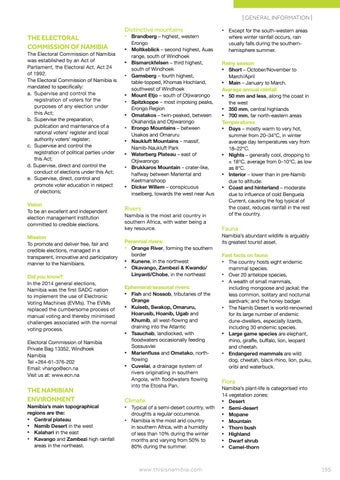| GENERAL INFORMATION |
Distinctive mountains
THE ELECTORAL COMMISSION OF NAMIBIA
The Electoral Commission of Namibia was established by an Act of Parliament, the Electoral Act, Act 24 of 1992. The Electoral Commission of Namibia is mandated to specifically: a. Supervise and control the registration of voters for the purposes of any election under this Act; b. Supervise the preparation, publication and maintenance of a national voters’ register and local authority voters’ register; c. Supervise and control the registration of political parties under this Act; d. Supervise, direct and control the conduct of elections under this Act; e. Supervise, direct, control and promote voter education in respect of elections; Vision To be an excellent and independent election management institution committed to credible elections. Mission To promote and deliver free, fair and credible elections, managed in a transparent, innovative and participatory manner to the Namibians. Did you know? In the 2014 general elections, Namibia was the first SADC nation to implement the use of Electronic Voting Machines (EVMs). The EVMs replaced the cumbersome process of manual voting and thereby minimised challenges associated with the normal voting process. Electoral Commission of Namibia Private Bag 13352, Windhoek Namibia Tel +264-61-376-202 Email: vhango@ecn.na Visit us at: www.ecn.na
THE NAMIBIAN ENVIRONMENT
Namibia’s main topographical regions are the: • Central plateau • Namib Desert in the west • Kalahari in the east • Kavango and Zambezi high rainfall areas in the northeast.
• Brandberg – highest, western • • • • • • • • • • •
Erongo Moltkeblick – second highest, Auas range, south of Windhoek Bismarckfelsen – third highest, south of Windhoek Gamsberg – fourth highest, table-topped, Khomas Hochland, southwest of Windhoek Mount Etjo – south of Otjiwarongo Spitzkoppe – most imposing peaks, Erongo Region Omatakos – twin-peaked, between Okahandja and Otjiwarongo Erongo Mountains – between Usakos and Omaruru Naukluft Mountains – massif, Namib-Naukluft Park Waterberg Plateau – east of Otjiwarongo Brukkaros Mountain – crater-like, halfway between Mariental and Keetmanshoop Dicker Willem – conspicuous inselberg, towards the west near Aus
Rivers
Namibia is the most arid country in southern Africa, with water being a key resource. Perennial rivers: • Orange River, forming the southern border • Kunene, in the northwest • Okavango, Zambezi & Kwando/ Linyanti/Chobe, in the northeast Ephemeral/seasonal rivers: • Fish and Nossob, tributaries of the Orange • Kuiseb, Swakop, Omaruru, Hoarusib, Hoanib, Ugab and Khumib, all west-flowing and draining into the Atlantic • Tsauchab, landlocked, with floodwaters occasionally feeding Sossusvlei • Marienfluss and Omatako, northflowing • Cuvelai, a drainage system of rivers originating in southern Angola, with floodwaters flowing into the Etosha Pan.
Climate
• Typical of a semi-desert country, with droughts a regular occurrence.
• Namibia is the most arid country
in southern Africa, with a humidity of less than 10% during the winter months and varying from 50% to 80% during the summer.
www.thisisnamibia.com
• Except for the south-western areas where winter rainfall occurs, rain usually falls during the southernhemisphere summer.
Rainy season • Short – October/November to March/April • Main – January to March. Average annual rainfall • 50 mm and less, along the coast in the west • 350 mm, central highlands • 700 mm, far north-eastern areas Temperatures • Days – mostly warm to very hot, summer from 20–34°C, in winter average day temperatures vary from 18–22°C. • Nights – generally cool, dropping to ± 18°C, average from 0–10°C, as low as 8°C. • Interior – lower than in pre-Namib due to altitude. • Coast and hinterland – moderate due to influence of cold Benguela Current, causing the fog typical of the coast, reduces rainfall in the rest of the country.
Fauna
Namibia’s abundant wildlife is arguably its greatest tourist asset. Fast facts on fauna • The country hosts eight endemic mammal species. • Over 20 antelope species, • A wealth of small mammals, including mongoose and jackal; the less common, solitary and nocturnal aardvark; and the honey badger. • The Namib Desert is world-renowned for its large number of endemic dune-dwellers, especially lizards, including 30 endemic species. • Large game species are elephant, rhino, giraffe, buffalo, lion, leopard and cheetah. • Endangered mammals are wild dog, cheetah, black rhino, lion, puku, oribi and waterbuck.
Flora
Namibia’s plant-life is categorised into 14 vegetation zones: • Desert • Semi-desert • Mopane • Mountain • Thorn bush • Highland • Dwarf shrub • Camel-thorn
195

